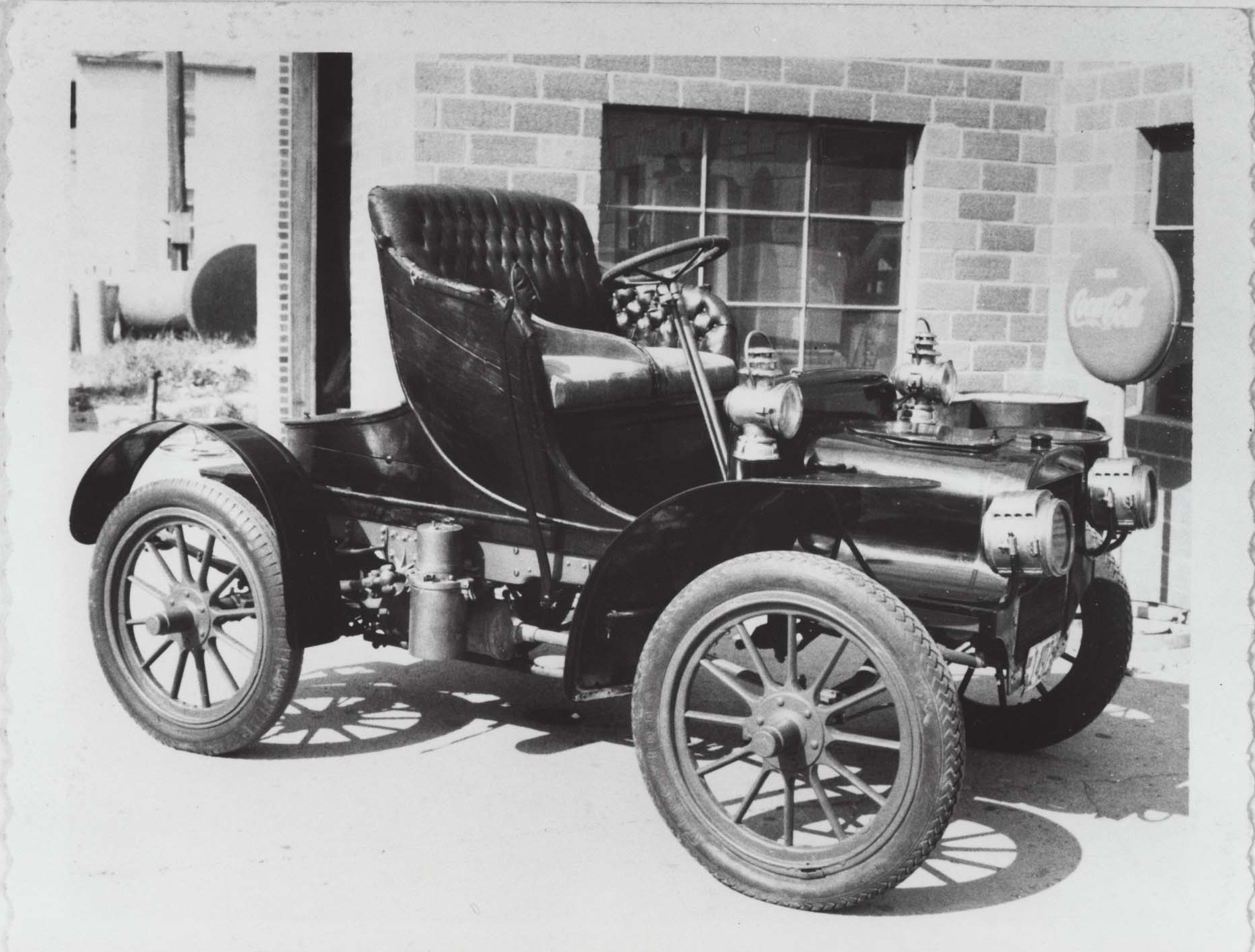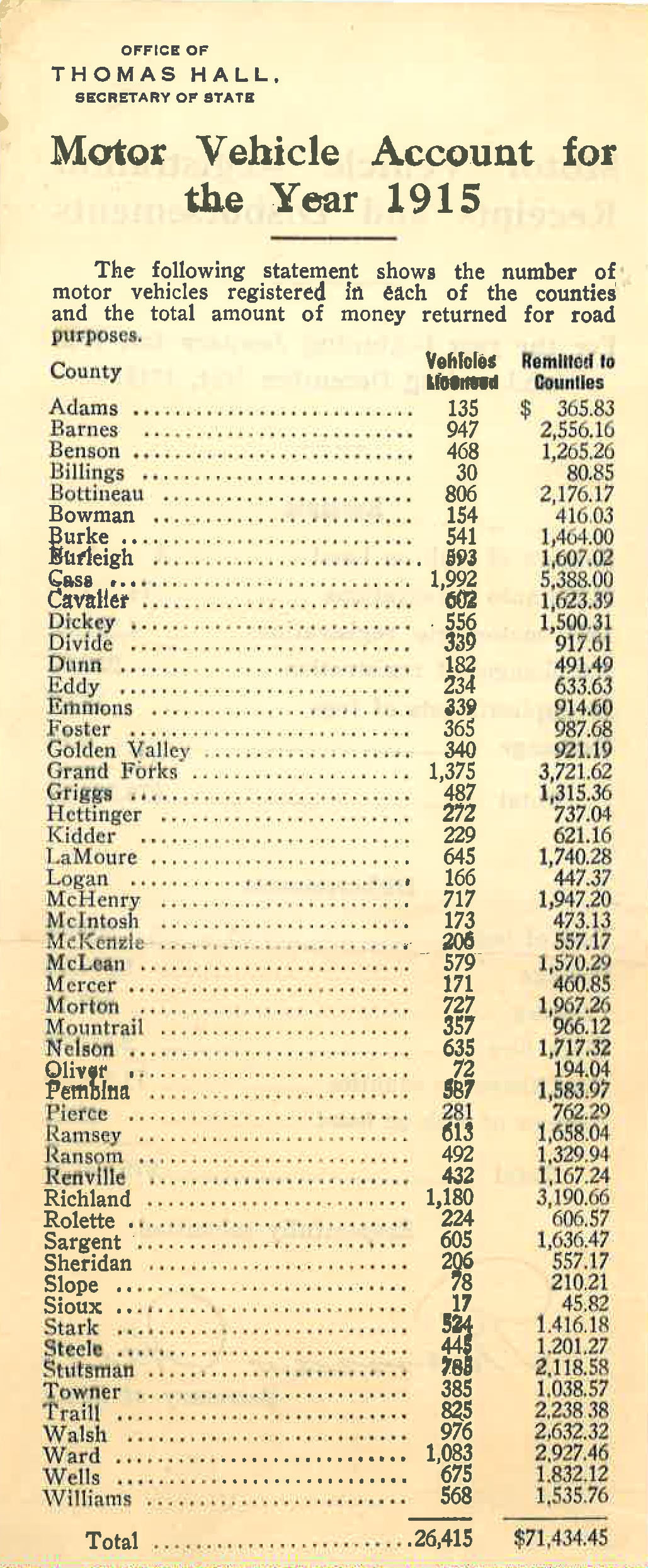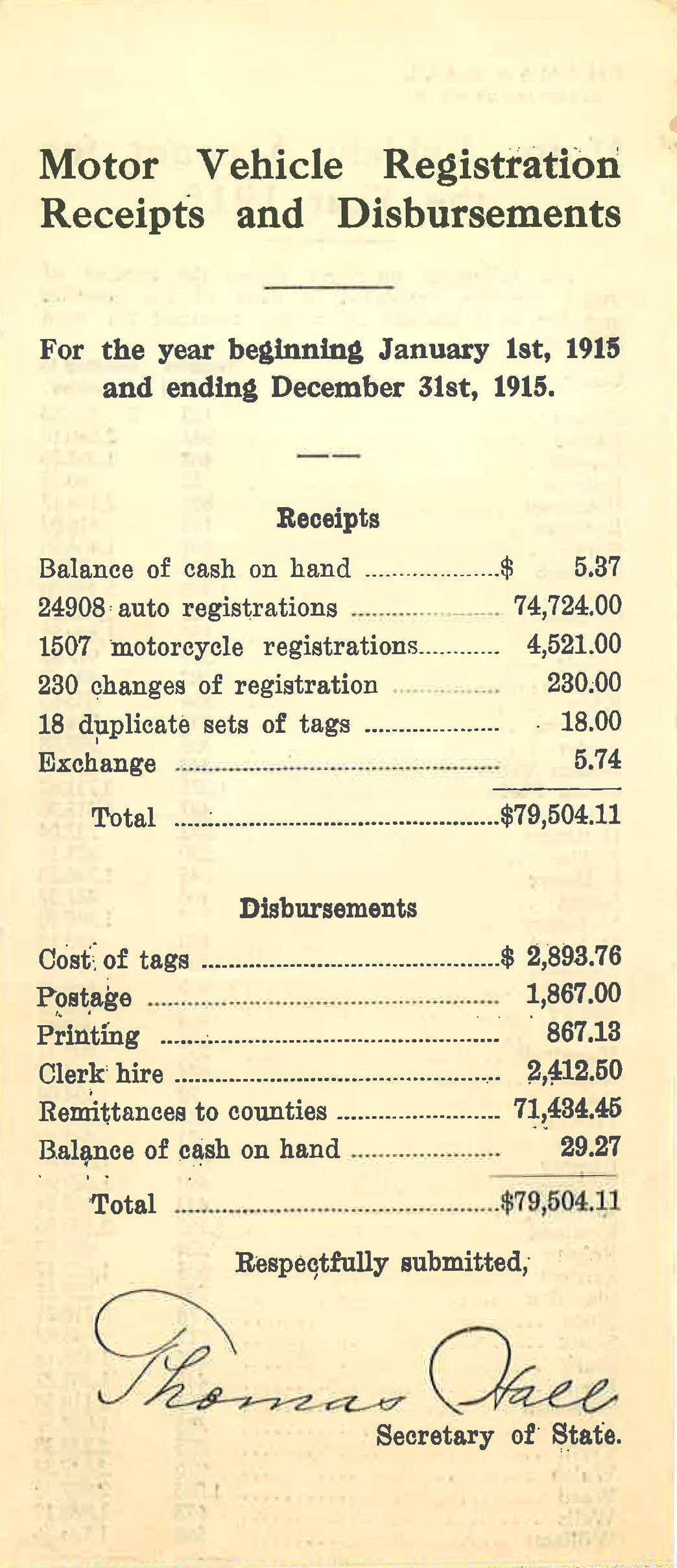The North Dakota legislature wrote the first laws concerning automobiles, driving, and safety in 1905. Compared to later legislation, this law was brief. The purpose of the law was to establish order in towns experiencing rapid changes in transportation.

The speed limits were set at eight miles per hour in town and twenty-five miles per hour in the open road (outside of city limits). Motorized vehicles were to have a muffler when driven in towns. Two lights were required on either side of the front of a car; one light was necessary for motorcycles. (See Image 8.) The rules of the road required a driver to move to the right when meeting an on-coming vehicle, and to move to the left when passing another vehicle. In the beginning, livestock-drawn vehicles and pedestrians always had the right of way. Cars were to have a bell or horn to sound when approaching a wagon drawn by livestock. If someone operating a horse-drawn wagon signaled the driver of a car, the driver had to stop until the wagon had passed. Violations of the 1905 law were punishable by a fine of up to $50 ($1297.38 in today’s dollars). In 1911, the legislature gave town governments the right to regulate motorized vehicle traffic. Town councils could also set speed limits. The 1911 law also required owners to registerBetween 1910 and 1911, Valley City, Northwood, and Dickinson issued license plates which cost drivers two or three dollars. These licensing and registration systems ended when the state began registering cars in in 1911. vehicles with the state. The registration form required a description of the vehicle (brand name, model, vehicle identification number); name and address of the owner; and a one dollar filing fee. In return, the secretary of state would issue two license “tags” with a “distinctive number” for each vehicle. Cars had more powerful engines by 1911, so the state highway speed limit was raised to 30 miles per hour. (See Document 3.)
The law also appropriated to each county an amount of money for “special road maintenance.” The money sent to the county treasuries was apportioned according to the number of vehicles registered in that county. In 1913, the legislature passed a law requiring vehicle tires to have the name of the manufacturer and the year of manufacture permanently written onto the tire in a “conspicuous” manner. This law prevented fraud in the sales of automobile tires. The law protected consumers which suggests that fraud in the manufacture and sale of auto parts had become a problem in North Dakota. The 1917 legislature recognized the increasing technological complexity of automobiles with its headlight law. The complicated law restricted “glaring headlights” to less than four candle-power. (See Document 4.)
Document 4: Headlights

To put this law into perspective we need to understand that one foot-candle of light is the amount of light that an average candle generates one foot away. This unit was replaced by the candela in 1948. One candlepower is equal to 0.981 candela. A car with headlights legally limited to 4 candle power had about 3.9 candela. Today, the federal government requires low beams on cars to have a minimum of 15,000 candela. If, in 1917, a car had more than 4 candle-power headlights, they had to be designed to the specifications shown in this diagram. Graphic: Jess Rockeman for SHSND
The 1919 legislature expanded protection for automobile owners. The repairs law required that any company selling automobiles (or trucks, tractors, steam or gas engines, and harvesting equipment) in North Dakota, must first establish at least one “supply depot” for parts and repairs in the state. The necessary repair parts would have to be kept on hand so that auto owners and farmers could expect to have their repairs done in a reasonable length of time.

The 1919 law required that the registration fee for automobiles be based on a complicated formula calculated from the selling price of the car on January 1 of the registration year (5 mills per dollar), horsepowerOne horsepower was measured by multiplying the square of the diameter of the cylinder in inches by the number of cylinders and dividing this product by two and one-half. (10 cents per horsepower), and vehicle weight (20 cents per hundred pounds). Every year after the first year of registration, the registration fee was discounted (between 10% and 40%) to account for the vehicle’s age. (See Document 5.) Registration records from 1911 indicate that the owners of 7,220 cars and trucks and 265 motorcycles registered with the Secretary of State in 1911. (See Image 9.)
Document 5: Registration Fees

A 1920 Ford Model T (the most popular car in the United States) would have cost a North Dakota owner $7.86 in registration fees in 1920. The following year, the fee would be 10 per cent less, or $7.08. In 1922, the registration fee was reduced by 40%, so the owner of the Model T would pay $5. Five dollars? Yep. Though the fee calculates to $4.72 the lowest fee allowed by law was $5. Graphic: Jess Rockeman for SHSND
A portion of automobile registration fees collected after 1919 were to be given to the State Highway Commission. The State Highway Commission used the money in combination with federal highway funds to construct “rural post roads” and other highways. Counties also received funds for county road maintenance. In the 21 years between 1898 and 1919, North Dakota entered the automobile age as residents realized the geographical, political, and economic implications of cars. The North Dakota legislature created an orderly process for keeping track of automobiles, maintaining order on state and town roads, and finding sources of funding for highways and other improvements. In a state with more space than people, the automobile was a welcome innovation.
Why is this important? The legislature had not passed laws requiring licensing of horse-drawn wagons, but automobiles presented a new set of challenges and advantages legislators could not ignore. One challenge was to help the owner maintain some legitimate claim to automobile ownership which was useful in case of theft. Another challenge was to provide safe roads for cars which were often built like wagons, but had speeds that made them far more dangerous to drivers and pedestrians. The advantages of automobiles to the state were enormous. Rapid transportation of goods and people had a positive effect on business. However, the legislature wanted to regulate ownership of automobiles and maintain high levels of safety on the roads. Legislators did not write laws requiring licenses for drivers for many more years, and the North Dakota Highway Patrol did not come into existence until 1935.






